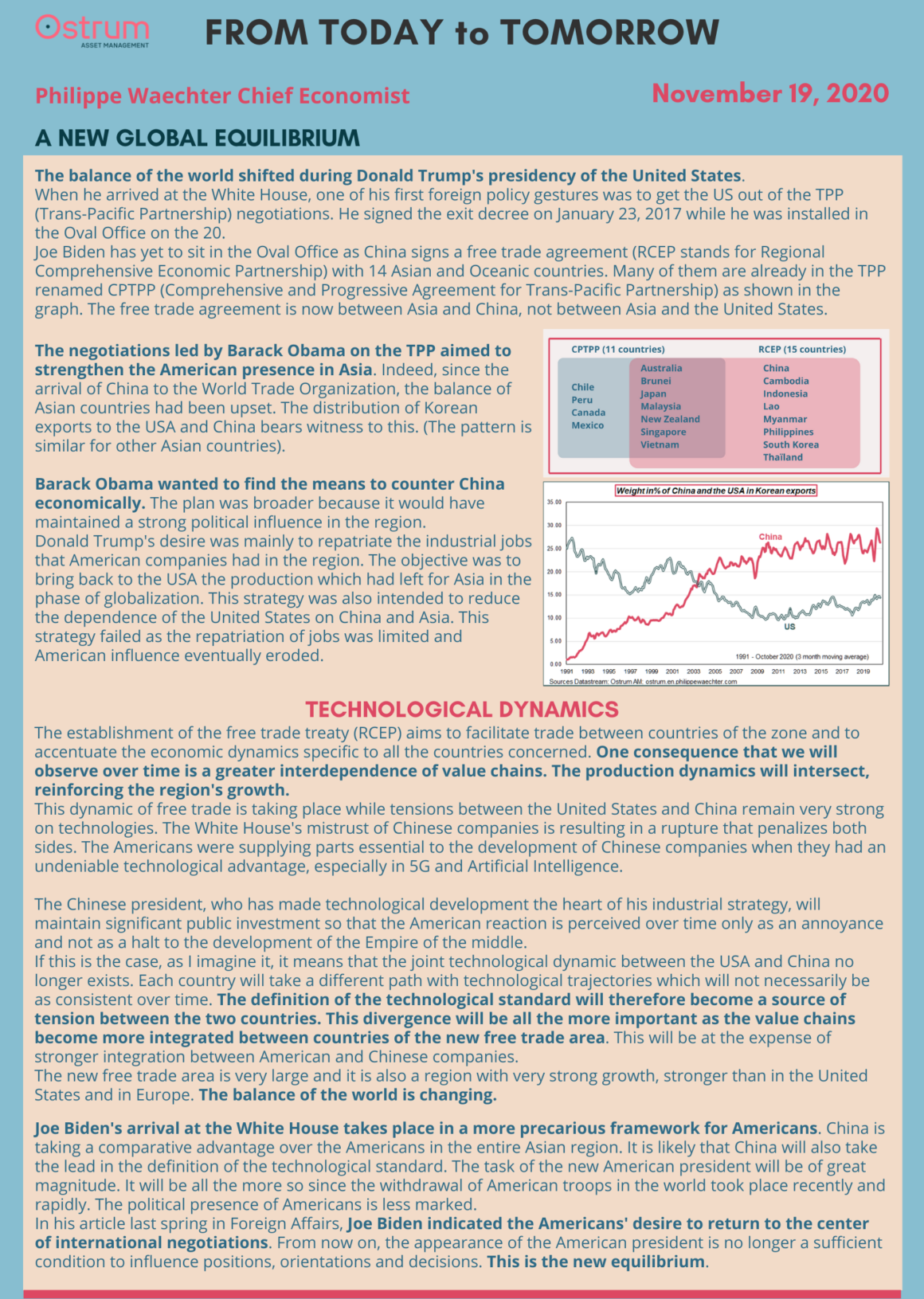The new free trade treaty is between Asia and China, the precedent should have been between Asia, excluding China, and the USA. Donald Trump decided otherwise upon his arrival at the White House on January 23, 2017, reducing American influence in Asia.
The future ex-president also tipped the technological balance between the Americans and the Chinese.
It is in this new world that Joe Biden’s international policy will have to be inscribed.
The balance of the world shifted during Donald Trump’s presidency of the United States.
When he arrived at the White House, one of his first foreign policy gestures was to get the US out of the TPP (Trans-Pacific Partnership) negotiations. He signed the exit decree on January 23, 2017 while he was installed in the Oval Office on the 20.

Joe Biden has yet to sit in the Oval Office as China signs a free trade agreement (RCEP stands for Regional Comprehensive Economic Partnership) with 14 Asian and Oceanic countries. Many of them are already in the TPP renamed CPTPP (Comprehensive and Progressive Agreement for Trans-Pacific Partnership) as shown in the graph. The free trade agreement is now between Asia and China, not between Asia and the United States.

The negotiations led by Barack Obama on the TPP aimed to strengthen the American presence in Asia. Indeed, since the arrival of China to the World Trade Organization, the balance of Asian countries had been upset. The distribution of Korean exports to the USA and China bears witness to this. (The pattern is similar for other Asian countries).
Barack Obama wanted to find the means to counter China economically. The plan was broader because it would have maintained a strong political influence in the region.
Donald Trump’s desire was mainly to repatriate the industrial jobs that American companies had in the region. The objective was to bring back to the USA the production which had left for Asia in the phase of globalization. This strategy was also intended to reduce the dependence of the United States on China and Asia. This strategy failed as the repatriation of jobs was limited and American influence eventually eroded.
Technological Dynamics
The establishment of the free trade treaty (RCEP) aims to facilitate trade between countries of the zone and to accentuate the economic dynamics specific to all the countries concerned. One consequence that we will observe over time is a greater interdependence of value chains. The production dynamics will intersect, reinforcing the region’s growth.
This dynamic of free trade is taking place while tensions between the United States and China remain very strong on technologies. The White House’s mistrust of Chinese companies is resulting in a rupture that penalizes both sides. The Americans were supplying parts essential to the development of Chinese companies when they had an undeniable technological advantage, especially in 5G and Artificial Intelligence.
The Chinese president, who has made technological development the heart of his industrial strategy, will maintain significant public investment so that the American reaction is perceived over time only as an annoyance and not as a halt to the development of the Empire of the middle.
If this is the case, as I imagine it, it means that the joint technological dynamic between the USA and China no longer exists. Each country will take a different path with technological trajectories which will not necessarily be as consistent over time. The definition of the technological standard will therefore become a source of tension between the two countries. This divergence will be all the more important as the value chains become more integrated between countries of the new free trade area. This will be at the expense of stronger integration between American and Chinese companies.
The new free trade area is very large and it is also a region with very strong growth, stronger than in the United States and in Europe. The balance of the world is changing.
Joe Biden’s arrival at the White House takes place in a more precarious framework for Americans. China is taking a comparative advantage over the Americans in the entire Asian region. It is likely that China will also take the lead in the definition of the technological standard. The task of the new American president will be of great magnitude. It will be all the more so since the withdrawal of American troops in the world took place recently and rapidly. The political presence of Americans is less marked.
In his article last spring in Foreign Affairs, Joe Biden indicated the Americans’ desire to return to the center of international negotiations. From now on, the appearance of the American president is no longer a sufficient condition to influence positions, orientations and decisions. This is the new equilibrium.
_______________________________________________________
This post is available in PDF format and as an infographic. Both can be downloaded



